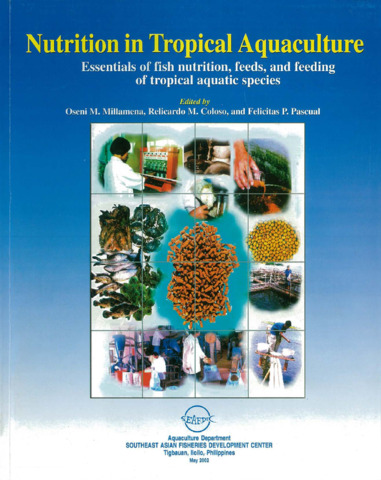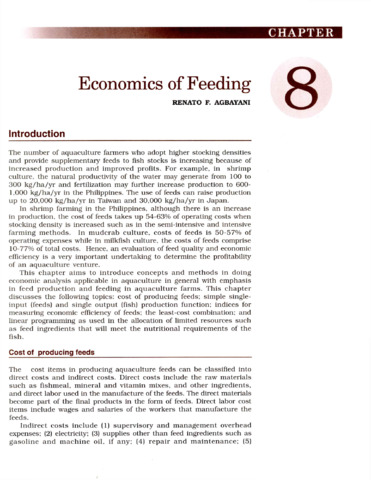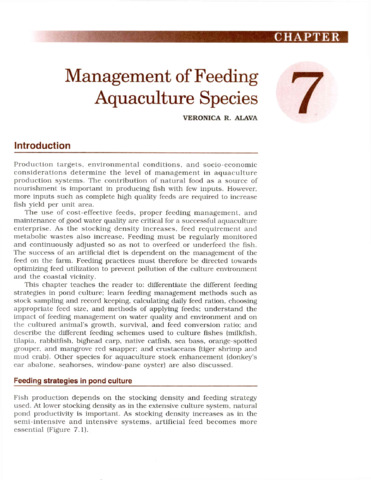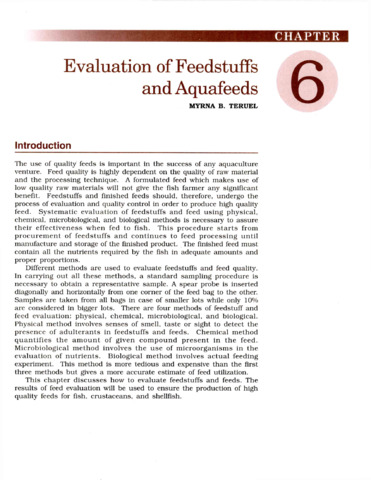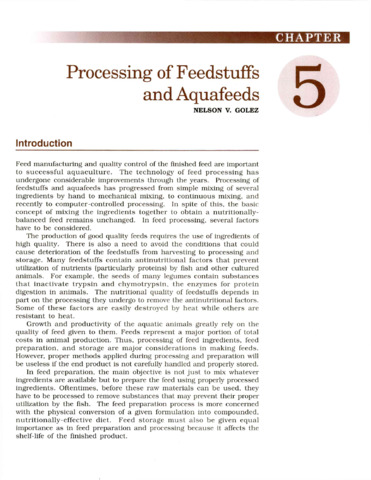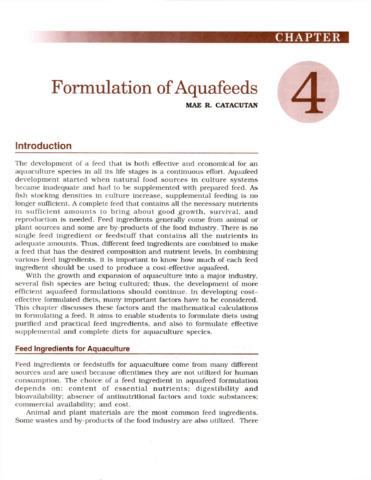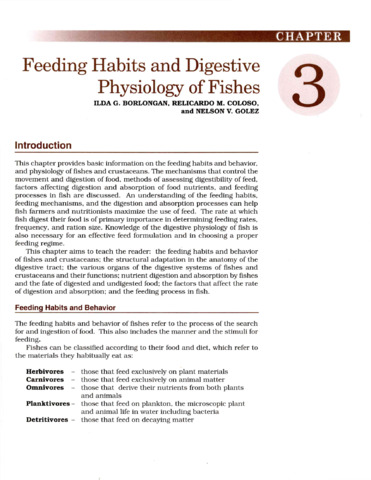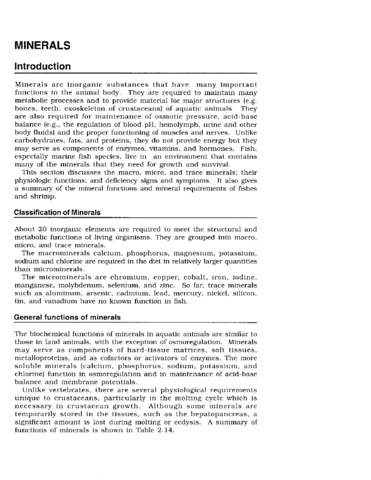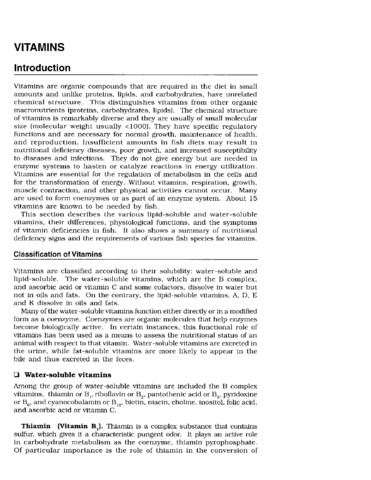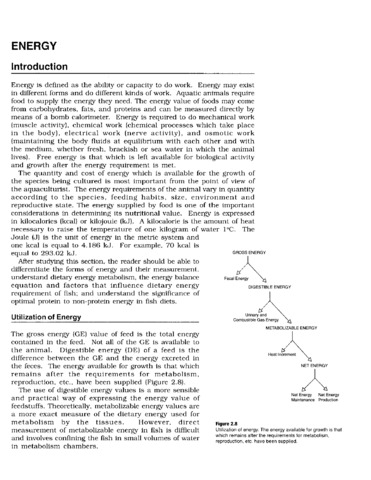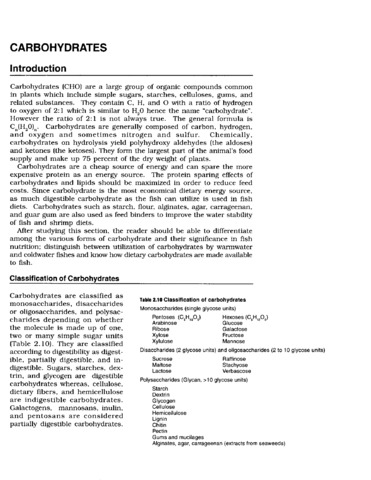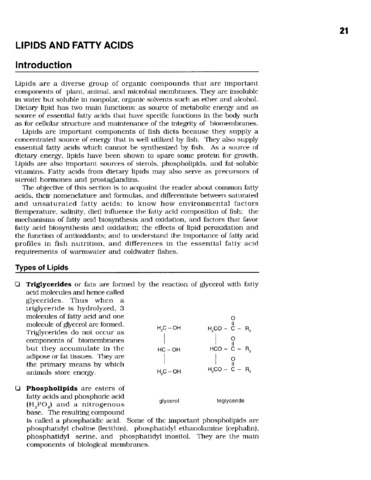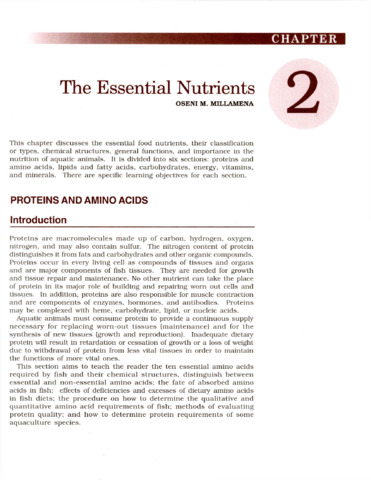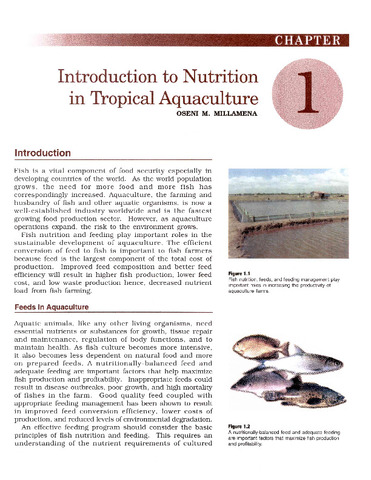Nutrition in tropical aquaculture : essentials of fish nutrition, feeds, and feeding of tropical aquatic species
ပစ်မှတ်ကိုကြည့်ပါ-
A 221-page book has eight chapters on aquaculture nutrition, feed formulation and feeding management. This book is the product of more than 25 years of research experience in fish nutrition and feed development at SEAFDEC/AQD.
Contents
- Foreword
- About the authors and editors
- Preface
-
Chapter 1
INTRODUCTION TO NUTRITION IN TROPICAL AQUACULTURE
Oseni M. Millamena- Feeds in aquaculture
- Feeds and the environment
- Sustainable approaches to aquaculture
- Summary
- Suggested readings
-
Chapter 2
THE ESSENTIAL NUTRIENTS
Oseni M. Millamena-
Proteins and amino acids
- Introduction
- Amino acids
- Classification of amino acids
- Essential amino acids
- Non-essential amino acids
- Classification of proteins
- Protein structure
- Fate of absorbed amino acids
- Importance of amino acid profiles in fish nutrition
- Qualitative amino acid requirements
- Quantitative amino acid requirements
- Deficiencies and excesses of dietary amino acids
- Evaluation of protein quality
- Protein requirement
- Guide questions
-
Lipids and fatty acids
- Introduction
- Types of lipids
- General function of lipids
- Fatty acids
- Structure and classification
- Nomenclature
- Fatty acid composition of fish
- Biosynthesis of fatty acids
- Oxidation of fatty acids
- Lipid peroxidation
- Importance of fatty acid profiles in fish nutrition
- Essential Fatty Acid Requirements of Fish
- Guide questions
-
Carbohydrates
- Introduction
- Classification of carbohydrates
- Monosaccharides
- Disaccharides and oligosaccharides
- Polysaccharides
- Utilization of carbohydrates
- Guide questions
-
Energy
- Introduction
- Utilization of energy
- Energy metabolism
- Energy balance and dietary requirement
- Dietary energy requirement
- Guide questions
-
Vitamins
- Introduction
- Classification of vitamins
- Water-soluble vitamins
- Lipid-soluble vitamins
- Vitamin requirements of fish
- Guide questions
-
Minerals
- Introduction
- Classification of minerals
- General functions of minerals
- Mineral availability
- Macrominerals
- Microminerals
- Mineral supplementation of practical fish diets
- Mineral requirements of fish
- Guide questions
- Summary
- Suggested readings
-
Proteins and amino acids
-
Chapter 3
FEEDING HABITS AND DIGESTIVE PHYSIOLOGY OF FISHES
Ilda G. Borlongan, Relicardo M. Coloso and Nelson V. Golez- Introduction
- Feeding habits and behavior
- Anatomy and physiology of the digestive system
- Fishes
- Crustaceans
- Digestion and absorption
- Digestion and absorption of proteins
- Digestion and absorption of carbohydrates
- Digestion and absorption of lipids
- Measurements and analysis used in digestion studies
- Measurements of stomach contents
- Measurement of digestibility
- Factors affecting digestion and absorption
- Feeding process in fish
- Appetite and satiation
- Arousal and search
- Location and identification
- Capture
- Taste testing
- Swallowing or rejection
- Summary
- Guide questions
- Suggested readings
-
Chapter 4
FORMULATION OF AQUAFEEDS
Mae R. Catacutan- Introduction
- Feed ingredients for aquaculture
- Feed formulation
- Pearson’s square and algebraic equation methods
- Trial and error method
- Linear program for least cost formulation
- Purified diet formulation
- Summary
- Guide questions
- Suggested readings
-
Chapter 5
PROCESSING OF FEEDSTUFFS AND AQUAFEEDS
Nelson V. Golez- Introduction
- Feedstuff processing
- Different methods of feedstuff processing
- Soaking
- Heating and cooking
- Dehulling
- Extraction with organic solvent and chemical treatment
- Feed preparation techniques
- Grinding
- Size grading or sieving
- Weighing
- Mixing
- Conditioning
- Pelleting and extrusion
- Pellet cooling and drying
- Pellet crumbler
- Pellet and crumbled feed cleaner
- Product packaging and storage
- Steps in large-scale feed preparation
- Steps in small-scale feed preparation
- Steps in larval feed preparation
- Quality control
- Feed mill sanitation and maintenance
- Summary
- Guide questions
- Suggested readings
-
Chapter 6
EVALUATION OF FEEDSTUFFS AND AQUAFEEDS
Myrna B. Teruel- Introduction
- Physical evaluation
- Use of the senses
- Feed microscopy
- Measurements of feedstuffs bulk density
- Attractability
- Water stability
- Chemical evaluation
- Proximate analysis
- Methods of protein evaluation
- Methods of lipid evaluation
- Method of vitamin evaluation
- Methods of mineral evaluation
- Methods of energy determination
- Analysis of toxins in feeds
- Microbiological evaluation
- Biological evaluation
- Parameters to be monitored in a feeding experiment
- Summary
- Guide questions
- Suggested readings
-
Chapter 7
MANAGEMENT OF FEEDING AQUACULTURE SPECIES
Veronica R. Alava- Introduction
- Feeding strategies in pond culture
- Production of natural aquatic food
- Feeding a supplementary diet
- Feeding a complete diet
- Feeding management
- Sampling and record keeping
- Feeding ration
- Feed particle size
- Feed application methods
- Feeding, water quality, and the environment
- Feeding, oxygen requirements, and water quality
- Fish farm wastes
- Performance measures
- Biomass
- Feed conversion ratio
- Feeding schemes
- Milkfish
- Tilapias
- Rabbitfish
- Bighead carp
- Native catfish
- Asian sea bass
- Orange-spotted grouper
- Mangrove red snapper
- Tiger shrimp
- Mud crabs
- Other species for Stock enhancement
- Donkey’s ear abalone
- Seahorses
- Window pane oyster
- Summary
- Guide questions
- Suggested readings
-
Chapter 8
ECONOMICS OF FEEDING
Renato F. Agbayani- Introduction
- Cost of producing feeds
- Single input and single output production function
- The production function and the cost of production
- Economic efficiency of feeds
- Least-cost combination of feeds
- Minimum cost of feed formulation using linear programming
- Summary
- Guide questions
- Suggested readings
-
APPENDIX
- Sample worksheet for calculating the nutrient composition of feed
- Methods of protein analysis (Kjeldahl Method)
- Crude fat analysis (Soxhtec Method)
- Lipid extraction (Bligh and Dyer Method)
- Saponification and transesterification
- Method of peroxide value determination
- Procedure of fatty acid value determination
- Thiobarbituric acid (TBA) value determination
- GLOSSARY
- ILLUSTRATION AND PHOTO CREDITS
- INDEX
နောက်ဆုံးပေါ်မှတ်ပုံတင်ပစ္စည်းများ
-
Nutrition in tropical aquaculture: Essentials of fish nutrition, feeds, and feeding of tropical aquatic species
(Aquaculture Department, Southeast Asian Fisheries Development Center, 2002)This book is intended to teach undergraduate students the essentials of aquaculture nutrition, feed formulation, and feeding management. It serves as a reference book for researchers in aquaculture, aquaculturists, fish ... -
Economics of feeding
(Aquaculture Department, Southeast Asian Fisheries Development Center, 2002)This chapter aims to introduce concepts and methods in doing economic analysis applicable in aquaculture in general with emphasis in feed production and feeding in aquaculture farms. This chapter discusses the following ... -
Management of feeding aquaculture species
(Aquaculture Department, Southeast Asian Fisheries Development Center, 2002)This chapter teaches the reader to: differentiate the different feeding strategies in pond culture; learn feeding management methods such as stock sampling and record keeping, calculating daily feed ration, choosing ... -
Evaluation of feedstuffs and aquafeeds
(Aquaculture Department, Southeast Asian Fisheries Development Center, 2002)This chapter discusses how to evaluate feedstuffs and feeds. The results of feed evaluation will be used to ensure the production of high quality feeds for fish, crustaceans, and shellfish. -
Processing of feedstuffs and aquafeeds
(Aquaculture Department, Southeast Asian Fisheries Development Center, 2002)This chapter will help the reader understand and appreciate the basic principles of processing, preparation, storage, and quality control in the preparation of aquafeeds. The material in this section is presented in sequence ... -
Formulation of aquafeeds
(Aquaculture Department, Southeast Asian Fisheries Development Center, 2002)The development of a feed that is both effective and economical for an aquaculture species in all its life stages is a continuous effort. Aquafeed development started when natural food sources in culture systems became ... -
Feeding habits and digestive physiology of fishes
(Aquaculture Department, Southeast Asian Fisheries Development Center, 2002)This chapter provides basic information on the feeding habits and behavior, and physiology of fishes and crustaceans. The mechanisms that control the movement and digestion of food, methods of assessing digestibility of ... -
The essential nutrients: Minerals
(Aquaculture Department, Southeast Asian Fisheries Development Center, 2002)This section discusses the macro, micro, and trace minerals; their physiologic functions; and deficiency signs and symptoms. It also gives a summary of the mineral functions and mineral requirements of fishes and shrimp. -
The essential nutrients: Vitamins
(Aquaculture Department, Southeast Asian Fisheries Development Center, 2002)This section describes the various lipid-soluble and water-soluble vitamins, their differences, physiological functions, and the symptoms of vitamin deficiencies in fish. It also shows a summary of nutritional deficiency ... -
The essential nutrients: Energy
(Aquaculture Department, Southeast Asian Fisheries Development Center, 2002)After studying this section, the reader should be able to differentiate the forms of energy and their measurement. Understand dietary energy metabolism, the energy balance equation and factors that influence dietary energy ... -
The essential nutrients: Carbohydrates
(Aquaculture Department, Southeast Asian Fisheries Development Center, 2002)This section discusses the difference among the various forms of carbohydrate and their significance in fish nutrition; distinguish between utilization of carbohydrates by warmwater and coldwater fishes and know how dietary ... -
The essential nutrients: Lipids and fatty acids
(Aquaculture Department, Southeast Asian Fisheries Development Center, 2002)The objective of this section is to acquaint the reader about common fatty acids, their nomenclature and formulas, and differentiate between saturated and unsaturated fatty acids; to know how environmental factors (temperature, ... -
The essential nutrients: Proteins and amino acids
(Aquaculture Department, Southeast Asian Fisheries Development Center, 2002)This section aims to teach the reader the ten essential amino acids required by fish and their chemical structures, distinguish between essential and non-essential amino acids; the fate of absorbed amino acids in fish; ... -
Introduction to nutrition in tropical aquaculture
(Aquaculture Department, Southeast Asian Fisheries Development Center, 2002)Fish is a vital component of food security especially in developing countries of the world. As the world population grows, the need for more food and more fish has correspondingly increased. Aquaculture, the farming and ...

